Side Menu:
Captain E.J. Smith - Demeanor and Death
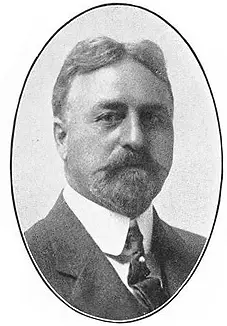
Major Peuchen: "The captain was
not quite himself"
There were some negative comments about Smith during the evacuation. For example Major Peuchen, who volunteered to help with lifeboat no.8 that had almost reached the water without enough sailors, was advised by Captain Smith to "go down below and break a window and get in through the window into the boat... The captain was not quite himself; his idea was impractical if not downright dangerous"
Women who lost their husbands often blamed Captain Smith for their loss by not allowing their husbands into lifeboats. Second class passenger Mrs Amin Jerwan, as reported in The New York Times, 19 April 1912, said: "Everybody on the ship blamed the Captain. The sailor who rowed our boat told me that he had followed the sea for 45 years and had never been I any kind of accident before, except on the Olympic when she rammed into the Hawke. 'That was under the same Captain,' he said 'and now I am having my second experience under him.'
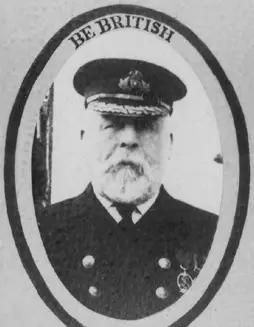
Panel portrait of Captain Edward John
Smith from a 1912 post-sinking memorial
card, remembered by the catch-phrase
"Be British," allegedly his final words,
although there is little evidence he
actually said this. (Click image to enlarge)
Second officer Lightoller reported Captain Smith using a megaphone during the evacuation, although cannot pinpoint a time: "I heard the Commander two or three times hail through the megaphone to bring the boats alongside, and I presumed he was alluding to the gangway doors, giving orders to the boats to go to the gangway doors... During the time I was launching the boats on the port side, I could not give you any definite time."(24.) "
There is one report of Smith drinking. According to millionaire Frederick M Hoyt, in the Peterson Morning Call, 23 April 1912, who had known Smith for 15 years, when he found Smith on the bridge towards the end he told him 'I feel like taking a drink before I take the plunge, don't you captain?' According to Hoyt they then went to Smith's cabin and both took a large drink to fortify them against the cold, after which Smith told him 'You will have to jump and you had better do it soon.' Hoyt suggested doing so from a lower deck and Smith apparently agreed that was a better option.
19 year old third class passenger Edward Dorking allegedly saw Smith towards the end down below in the engine room giving orders "The perspiration was pouring down his face in streams but he was calm and collected, and as I recollect him now, he appeared like a marble statue after rain." - (Bureau County Republican 2 May 1912)
Reports of his Death
There are many reports of Captain Smith's last moments. Here are some of the most notable:
First class saloon steward Frederick Ray testified at the US Inquiry that Captain Smith's personal steward Arthur Paintin was "last seen on the bridge, standing by the captain." (25.)
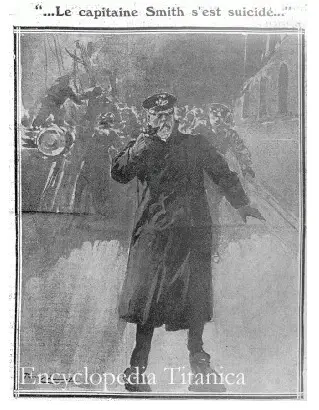
Captain Smith is portrayed as committing suicide
in the French paper L'Excelsior, 20 April 1912,
in a drawing by Paul Thiriat (courtesy
Olivier Mendez/ET)
Second class passenger William Mellors saw Smith come out on the deck "The brave old seaman was crying" and he then saw Smith jump from the bridge as the waters rose.
Fireman, James McGann, who found himself with Captain Smith on the bridge, confirms Mellors account of the Captain crying: “I was helping to get off a collapsible boat. The last one launched when the water began to break over the bridge on which Captain Smith stood. When the water reached Captain Smith's knees and the last boast was at least 20 feet away from the ship, I was standing beside him. He gave one look all around, his face firm and his lips hard set. He looked as if he was trying to keep back the tears, as he thought of the doomed ship. I felt mightily like crying as I looked at him. Suddenly he shouted: 'Well boys, you've done your duty and done it well. I ask no more of you. I release you. You know the rule of the sea. It's every man for himself now, and God bless you'."(Somerset County Gazette, 16 April 2012)
Wireless operator Harold Bride who was struggling to help launch collapsible B, saw Captain Smith dive from the bridge into the sea, adding that this occurred at the same moment that the collapsible was washed overboard.
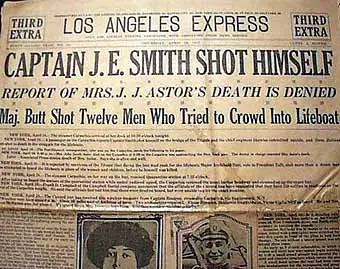
Early newspaper reports stated Captain Smith shot himself.
Eleanor Widener, who helped host the dinner honoring Captain Smith just hours before, corroborated the story of him diving off the bridge, and because her lifeboat was one of the last to leave the Titanic, she could have been close enough.
Mr Isaac Hiram Maynard , a cook on the Titanic said:-"I saw the captain standing on the bridge. He was fully dressed and had his cap on. When the water rushed over the top deck, the remaining boats were carried away. Another rush of water washed me overboard, and as I went I clung on to one of the upturned boats. There were some six other men clinging to the woodwork when we were in the water. I saw Captain Smith washed from the bridge, and afterwards saw him swimming in the water. He was still fully dressed, with his peak cap on his head. One of the men clinging to the raft tried to save him by reaching out a hand, but he would not let him, and called out 'Look after yourselves, boys.' I do not know what became of the captain, for I could not see him at the time, but I suppose he sank. - The Globe, 29 April 1912
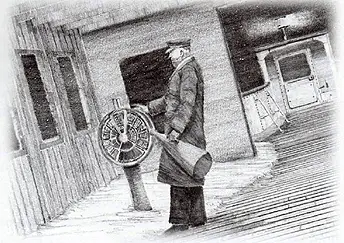
A pencil sketch of 'Captain Smith's last command'
by © Simon Fisher (Click image to enlarge)
Colonel Archibald Gracie, one of the passengers fortunate enough to have made his way to collapsible B, reported that he witnessed a man swimming up to the capsized boat which Gracie was clinging to. Those balanced on the collapsible shouted out their concern that taking any more aboard would jeopardize their stability. The swimmer shouted back in a strong voice, “All right boys. Good luck and God bless you.” Gracie, a reliable witness who later chronicled the events of that night, did not recognize the man with any degree of certainty, but others insisted that it was Captain Smith himself.
Stoker Harry Senior, also a collapsible B survivor, described the scene this way: “As I was swimming to the boat, I saw the Captain in the water. He was swimming with a baby in his arms, raising it out of the water as he swam on his back. He swam to the boat, put the baby in, and then swam back to the ship.” Second Officer Lightoller was present on collapsible B, but never gave any indication that such an event took place.
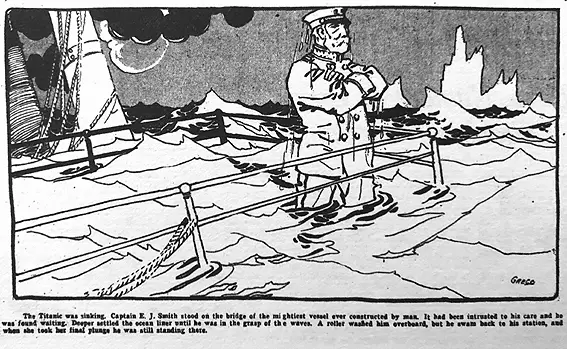
The Denver Post 19 April 1912 (Click to enlarge)
Trimmer James McGann reaffirmed Senior’s story, adding that he was with the Captain moments before the ship went down. Each of the men took hold of a child and leaped into the water in an attempt to save the young ones. "He took one of the two little children who were on the bridge beside him. They were both crying. He held the child, I think it was a little girl, under his right arm, and jumped into the sea. All of us jumped. I jumped right after the captain, but I grabbed the remaining child before I did so. When I struck the water the cold was so great I had to let go of the kiddie...I looked around for the captain after I got to the overturned boat, but he was nowhere i nsight." (Yorkshire Post, 23 April 1912)
Fireman Walter Hurst, One of the Collapsible B survivors, in a letter he wrote to author Walter Lord, he apparantly tried to reach Smith with an oar, but the rapidly rising swell carried the man away before he could reach him. Hurst wrote: " I can state Definitely Captain Smith did not reach the raft but I always had the idea he was the man that spoke to us in the water but I could not be sure." (undated letter, courtesy of Paul Lee, http://www.paullee.com/titanic/whurst.html)
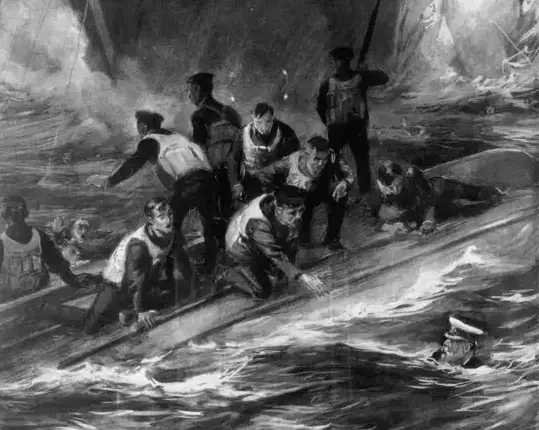
The Graphic newspaper portrays Captain Smith in the water and reaching upturned collapsible B. (Click to enlarge)
23 year old Charles Eugene Williams's account is “second-hand” in that he related it to his “friend George E. Standing” who in turn passed it on to reporter for The Daily Sketch. The article was printed on April 30, 1912 (courtesy of Tad Fitch and Bill Wormstedt, Shots in the Dark 12.)): “I saw Captain Smith swimming around in the icy water with a baby in his arms and wearing a lifebelt. He handed the baby to someone in the lifeboat, but refused to get in himself. The Captain did ask what became of First Officer Murdoch. We told him that he had blown his brains out with a revolver. Upon hearing this, Captain Smith pushed himself away from the boat, took off his lifebelt, and sank beneath the surface.”
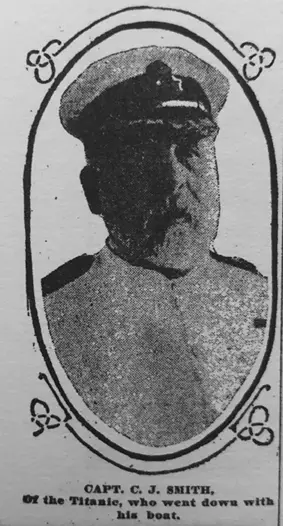
Robert Williams Daniel - The New York Herald in its 19 April 1912 edition quoted Robert Williams Daniel, who jumped from the stern immediately before the ship sank, in its 19 April 1912 edition as having claimed to have witnessed Captain Smith drown in the ship's wheelhouse. "I saw Captain Smith on the bridge. My eyes seemingly clung to him. The deck from which I had leapt was immersed. The water had risen slowly, and was now to the floor of the bridge. Then it was to Captain Smith's waist. I saw him no more. He died a hero."
Harold H. Lee, a waiter aboard Carpathia, passed on a tale he said he heard from one of Titanic’s quartermasters. The claim was that Captain Smith had committed suicide shortly before the ship sank, having headed calmly into the chart room (or the wheelhouse, according to other alternatives) and firing his revolver through the right side of his head. Lee added that this occurred only after the Captain was satisfied that all human efforts to save those aboard the Titanic had been fulfilled.
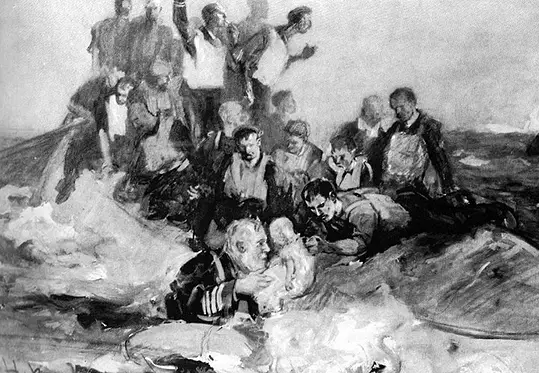
A period artist’s depiction of one alleged end of Captain Smith, where he purportedly brought a baby to overturned Collapsible B ( source: historyextra.com).
(Click to enlarge)
First-class passenger Gretchen Longley, told reporters directly that Smith had unsuccessfully tried to kill himself in the library two other times that evening, saved only because several officers rushed him and tore away his gun. Only then did Smith head up to the bridge, placing the muzzle into his mouth and shooting himself.
Another survivor, First Class passenger Ruth Dodge, told yet another story. “Then I saw a man who I am sure was Captain Smith. He was being pushed into a life raft. He flung his arms about and struggled like a mad man. It was easy to see he did not want to go. But the men who pushed him (probably the remaining ship’s officers) insisted and at length they got him onto the raft. He looked wildly about for a moment, waving his arms in despair and supplication. Then he leaped off the raft into the ice-caked area which closed over his head forever. A woman in my boat moaned and fainted when she saw the captain take his life and I felt sick at heart for I thought of my absent husband.”
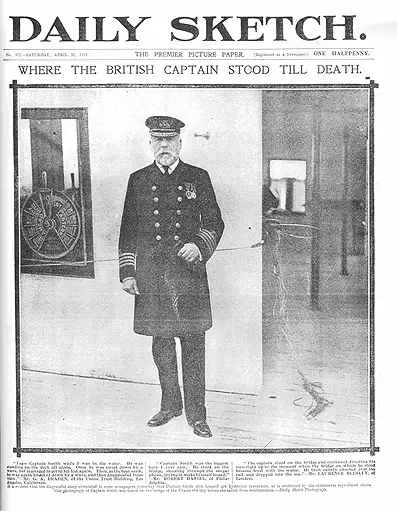
The Daily Sketch pays tribute to Captain Smith and
defends rumours of suicide on the 20th of April, 1912. (Click to enlarge)
Interestingly, The Daily Sketch of Saturday April 20, 1912, ran a front page tribute to Captain Smith, writing "It is evident that the disgraceful story circulated in some newspapers yesterday that Captain Smith shot himself are hysterial inventions" The newspaper then proves this with three quotations:
"I saw Captain Smith while I was in the water. He was standing on the deck all alone. Once he was swept down by a wave, but managed to get to his feet again. Then, as the boat sank, he was knpcked down by a wave, and then disappearted from view." - Mr G.A. Braden (Brereton), Los Angeles, California
"Captain Smith was the biggest hero I ever saw. He stood on the bridge, shouting through the megaphone, trying to make himself heard." - Mr Robert Daniels, Philadelphia
"The captain stood on the bridge and continued directing his men right up to the moment when the bridge on which he stood became level with the water. He then calmly climbed over the rail and dropped into the sea." - Mr Laurence Beesley, London
Just before returning aboard the Carpathia to resume his interrupted voyage, Captain Rostron also made a dramatic statement regarding Captains Smith's end:
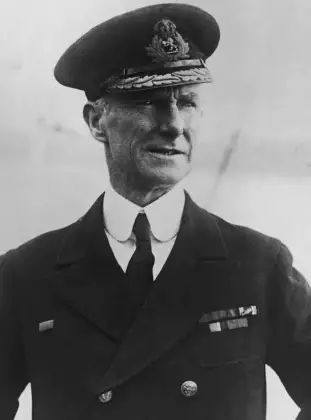
Captain Rostron descibed Captain Smith as reaching
the "edge of a lifeboat. But he tumbled back into
the ocean and went down."
"I wish you would deny in as strong language as permissable the persistent report sent out by some press concerns that Captain Smith killed himself when he realized that the Titanic was doomed. I have it from the lips of members of the his crew who tried to save his life that he did not committ suicide. He stuck to the ship until he was washed from the bridge.
Then some men caught him in the swirling waters and landed him safely on the edge of a lifeboat. But he tumbled back into the ocean and went down. He had been too weakened by hard knocks while being tossed about the sinking Titanic to hold onto anything. The buffeting he encountered on the wrecked ship undoubtedly had dazed him and left him in no condition to exert even his remaining strength.
Smith was one of the coolest, bravest and more careful commanders I have ever known. His seamanship was of the highest order. Too high a tribute cannot be paid to him by anybody who knew him." (Chicago Examiner, Apirl 19th, Vol 10 no.104)"
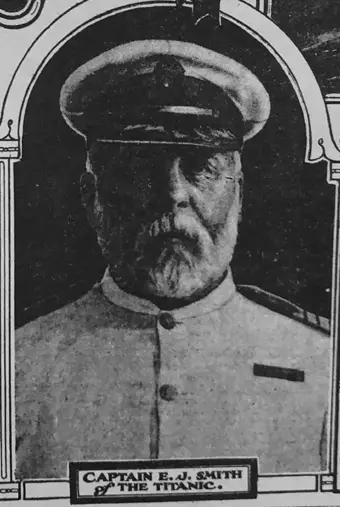
New York Herald April 21 1912
Perhaps the most unusual story came from Peter Pryal in mid-July, three months after the sinking. Pryal served as quartermaster during Smith’s tenure as captain of the Medic twenty years earlier. As a retired seaman, Pryal was living in Baltimore in 1912. He was on his way to his doctor when he spotted a man carrying two suitcases and wearing a light brown business suit, straw hat, and tan shoes. Pryal was convinced that the man was Captain Smith. Pyral tried to speak to him but there was no response. He then saw him a second time and they spoke briefly during which the man confirmed he was Captain Smith, but then departed for Washington.. The White Star Line later passed off the incident as mistaken identity and the story later died out after a few days of newspaper coverage.
In a Thursday 1st of August 1912 article published in London,Pyral's story was described as being "received with incredulity at the offices of the White Star Line here...We have heard nothing to indicate that Captain Smith did not meet death when the Titanic went down," said the manager. "This Baltimore captain's story must be either the result of delusion or mistaken identity." (Library of Congress/Encyclopedia Titanica)
Biographer G.J Cooper in his book Titanic Captain - The Life of Edward John Smith writes:
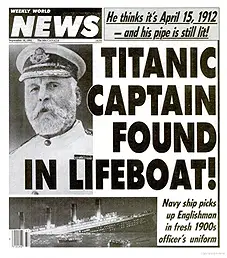
Captain Smith's death even became
the subject of tabloid "fake" news
about his "reappearance". More
information here.
"It is now generally accepted by historians of the Titanic that the most likely of these fates, the one documented in this book, was that Smith returned to the bridge and dived into the sea when the ship began her final plunge. If that was the case it was also possible that Smith could have swum around in the water for a time and may have refused to let himself be rescued as some statements say…Considering the odium heaped upon the likes of Ismay and Captain Lord, it was probably just as well that Smith died, as had he lived the scandal would probably have destroyed him." 60.)